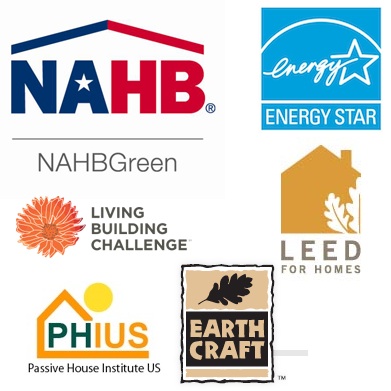
Green home certification programs are starting to reach a level of maturity. At the national level, LEED for Homes has established itself as the national industry leader, at least from a branding standpoint. NAHB’s National Green Building Standard (NGBS) has a growing following but, in my opinion, is still struggling to gain broad industry acceptance. Energy Star completed its transition to Version 3 in 2012, significantly raising the bar for certification, and, it appears, losing some market share in the process.
The Passivhaus standard continues to influence industry thinking and discussion, possibly out of proportion to its actual impact on the market. The Living Building Challenge is out there on the cutting edge, still having only certified a few (mostly commercial) buildings.
What’s up locally?
Many local and regional programs, once close to 200 in number, appear to be losing market share, some to the national certifications. As construction slowed at the beginning of the latest recession, many single-family builders eliminated third-party certification.
Several large builders created their own green branding programs, some of which barely meet the current energy code.
EarthCraft House, the Southeastern U.S. program that I am most familiar with, now relies primarily on multifamily certifications, much of that in the affordable market. Single-family home certification, once the mainstay of EarthCraft, is a small part of a much smaller new home market.
Some local programs have shut down, and, I expect, that others will do so as well. Please share any stories about the status of local programs in your area.
Changes, changes, changes
The national programs are all undergoing significant transitions. The latest version of LEED for Homes, originally called 2012 and then renamed to Version 4, recently completed its fifth public comment period and is scheduled to be voted on during the summer of 2013, and, hopefully released late in the year.
Interestingly, USGBC is currently planning to allow projects to be certified under the current or the upcoming versions of LEED for Homes for as long as three years after the release of Version 4. Since the current version of LEED for Homes still relies on Energy Star Version 2 requirements for its energy efficiency prerequisites and credits, there is a plan to raise the energy efficiency requirements in the current version of LEED for Homes in early 2013.
The 2012 NGBS, also known as ICC 700, is planned for release in early 2013. There will be a short period of approximately three months when builders can use either the current or new versions. Following this, all new projects must use the new standard for certification.
Energy Star has also introduced a multifamily certification program to address high-rise buildings that are subject to commercial building codes.
Where are we going?
While single-family home certification won’t go away, I believe that it will take a while for the demand for certified homes to grow. One industry bright spot is multifamily housing. A large portion of affordable housing in many states is green certified, and many market-rate buildings are now seeking certification. This is good luck for the residents of these buildings – they will get to reap the health, comfort, and efficiency benefits, and, hopefully, demand the same when they move into new apartments, condos, and homes down the road.
It will be interesting to see how this will all shake out. I believe that ENERGY STAR will slowly recapture some of its market share. LEED and the NGBS will continue to grow their share, probably at the expense of local programs, with much confusion as the new versions are released and phased in over the next several years. Then we will see another round of program updates and the process will start over again.
Confusing? Sure, but it’s also a bit of job security for us raters and consultants.
Weekly Newsletter
Get building science and energy efficiency advice, plus special offers, in your inbox.















One Comment
Alphabet Soup
The trouble with all these acronym programs and certifications is that, at their core, lies a bureaucracy seeking to secure its future and fatten its bottom line via fees.
As an engineer, HVAC contractor, energy auditor, and retrofit installer I'm constantly confronted with an endless alphabet soup of organizations, to wit: PH, LEED, USGBC, BPI, NCI, ACCA, ACI, NATE, ACEEE, Energy Star, CEE Tiers.
Our clients face the same quagmire, too. How do we and our clients sort through all the chaff in search of a building envelope that works for the climate and internal systems (HVAC, hot water, lighting, laundry, media, kitchen) that cost effectively deliver required results?
That's the core challenge - attain a pretty good house and fairly efficient sub-systems without getting misled or otherwise scammed.
Log in or create an account to post a comment.
Sign up Log in